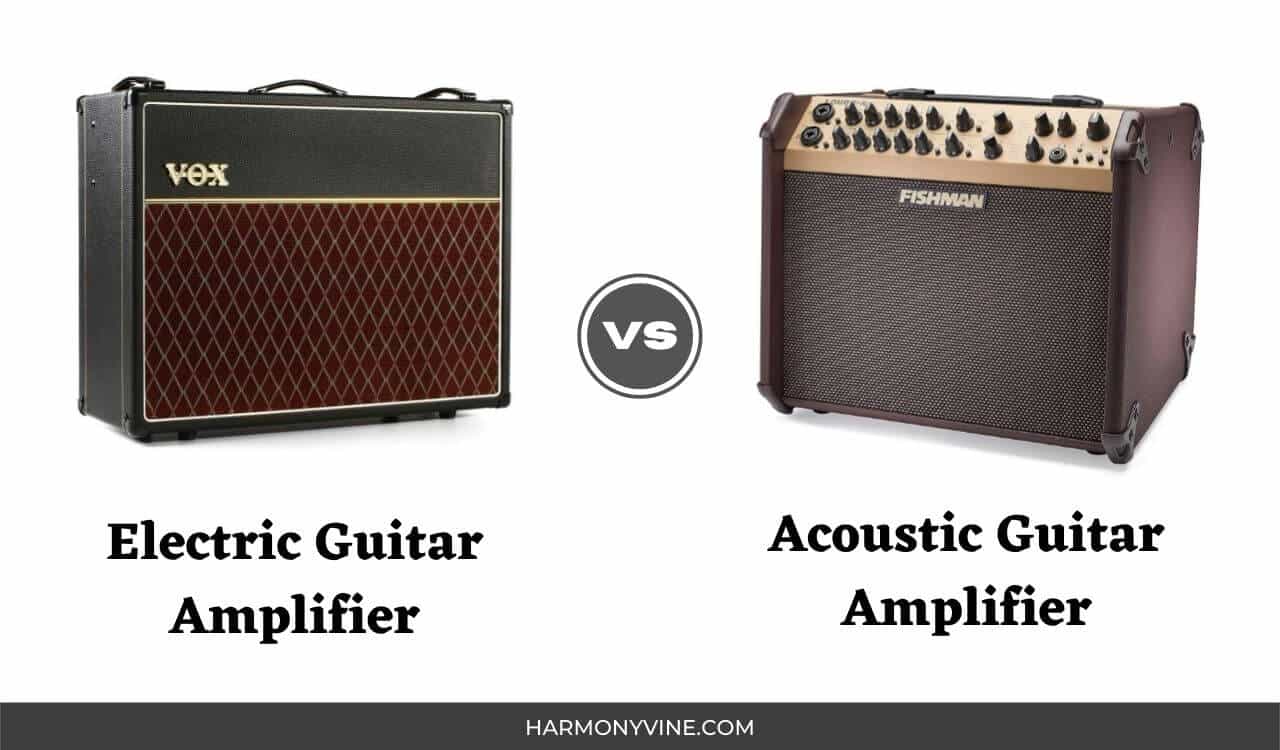If you own an electric guitar, you have a myriad of amps to choose from. The same applies to an acoustic guitar as well, but with a caveat.
Chances are that if you own both an electric and acoustic guitar, you’ve probably noticed that there are separate amps for both.
Perhaps you’re wondering which one you should get. In that case, keep reading!
In this guide, you’ll learn:
- What’s the difference between an acoustic guitar amp and an electric guitar amp?
- Can you play your acoustic guitar through an electric amp, and vice versa?
- Can you use the same amp for both?
Let’s dive into our in-depth comparison of an acoustic amp vs electric amp!
Electric Guitar Amp: Overview
Electric guitar amps are an integral part of what makes playing electric guitar so great. If we’re being honest, electric guitars look cool, but they wouldn’t be nearly as attractive without the power of an electric guitar amp to back them up.
In fact, without an amp, you’d have trouble hearing an electric guitar above just about anything else.
Electric guitar amps come in many different shapes and sizes, ranging from battery-powered, pocket-sized practice amps like the Danelectro Honeytone N-10, to tube-powered combo amps like Fender’s Blues Deluxe to arena-ready full stacks like Marshall’s 1959 HW.
There are also a few good amps for busking for those interested in street performance.
Every design is slightly different, with a different end goal in mind. Some amps are made for a crisp and clean sound, while others are better suited for high-gain distortion.
Beneath the mountains of speakers and electronics though, there are similarities between all electric guitar amps. Some common control knobs you’ll find are Gain, Volume (there’s a difference), and Tone. These control how your guitar sounds through the amp just like the Low, Mid, and High frequency knobs you’re also likely to find.
Acoustic Guitar Amp: Overview
Acoustic guitar amps aren’t a necessary piece of gear like electric guitar amps. You can play an acoustic guitar without an amp and it will still sound great. If you’re a gigging musician though, an acoustic guitar amp might be a good investment.
The nature of an acoustic guitar allows it to sound best when it’s not plugged into anything. The resonance of the acoustic guitar’s body when played is a huge part of what makes it so attractive, but acoustic guitars simply aren’t loud enough to be heard in clubs and on stages. That’s where the acoustic guitar amp comes into play.
Acoustic guitar amps aren’t just PA (Public Address) systems. They often have more controls and effects settings designed to emphasize an acoustic guitar’s natural sound – which is different from that of an electric guitar with no natural resonance.
Acoustic Amp vs Electric Amp: Key Differences
Acoustic and electric guitar amps are fundamentally similar when considering their design and construction. Both are made to take a small signal from your guitar, amplify it, and allow you to make tonal adjustments with various control knobs. However, there are small differences that optimize each for its intended purpose.
Design
If you’re familiar with various types of electric guitar amps, then you’ve probably heard the terms “tube,” “solid-state,” and “hybrid.”
An electric guitar amp can come with vacuum tubes in the preamp or power amp stages of its signal path (or both), or with transistors instead, making it “solid-state.” Hybrid amps feature a combination of the two, creating an even broader tonal pallet for electric guitarists.
Acoustic guitar amps only come with solid-state pre and power amps, and the reason is pretty simple -DISTORTION!
Vacuum tubes tend to color any tone, and distort when overloaded with signal, so they’re best suited for electric guitar amps. Transistor-based amp designs allow players to crank up the volume without having to worry about distortion, making them excellent for acoustic guitar amps.
Inputs & Controls
Many of the controls are similar between acoustic and electric guitar amps.
Both will have Volume, Tone, and EQ settings, but you usually will only find Feedback control on acoustic guitar amps. This is simply because acoustic feedback (when high frequencies get caught in a loop between the speaker and the acoustic pickup) is only possible when playing an acoustic guitar through an amplifier.
You can force an electric guitar to feedback, but you have to force it – meaning a mitigation control isn’t necessary.
Most acoustic guitar amps you’ll find come with XLR inputs, but you’ll almost never see this on an electric guitar amp. The reason is that XLR cables carry a balanced signal, and balanced signal means a clean signal. The goal of acoustic guitar amps is clarity, so they make it readily available via XLR inputs. Some acoustic guitar amps even come with an XLR-designated channel for a microphone!
Speakers
Another one of the key differences you might notice between acoustic and electric guitar amps is the speakers. Electric guitar amps most often come with one, two, or even four speakers, depending on the size of the amp, and they’re usually all the same size.
Acoustic guitar amps often come equipped with one main speaker accompanied by several much smaller speakers, also known as tweeters. The tweeters allow your amp to better reproduce the natural sound of your guitar, as many of the nuances come from a higher frequency range.
Sound
It’s important to mention that electric guitar amps are designed to work well with electromagnetic pickups, and acoustic guitar amps are designed to work with piezo pickups. The difference is in the size of the signal each produces, which results in a vastly different sound.
Electromagnetic pickups produce a signal that’s proportional to the intensity of your playing, while piezo pickups produce signal exponentially.
For example, if you play your electric guitar twice as hard, your pickups will produce a signal twice as large. Piezo pickups, on the other hand, would produce a signal nearly four times as large under the same conditions, with the same playing.
Acoustic and electric guitar amps then, are designed to handle these respective differences, and produce a sound that’s authentic to the instrument.
The whole point of an acoustic amp is to be as transparent as possible in order to emphasize the natural sound of the acoustic guitar, while an electric guitar amp is designed to add color and character to the dry signal of an electric guitar.
The frequency response of an electric guitar amp is almost always smaller than that of an acoustic guitar amp. While acoustic and electric guitars share the same fundamental frequency range, the sympathetic frequencies characteristic of an acoustic guitar span a broader range than that of an electric guitar.
That can be simplified by saying that acoustic guitars are characteristically brighter and more brilliant than electric guitars, so their amplifiers are designed to reproduce those characteristics. Electric guitar amps are designed to add effects, tonal colorations, and just about anything you can imagine.
Versatility
Whether you’re a regularly gigging guitarist or a complete beginner, there are options available for both electric and acoustic guitar amplification.
There are electric and acoustic guitar amps suitable for every type of stylistic application, in any type of venue. Finding the right amp for your needs is a personal decision and usually comes down to intended use and budget.
If you’re torn between purchasing an electric guitar amp or an acoustic guitar amp, consider which instrument you’ll play more often – your acoustic guitar or your electric guitar? There’s no need to go with an electric guitar amp if you intend to play acoustic more often, and vice versa.
There are acoustic/electric guitar amps available that function as hybrid amps. These are usually tube-driven, with two separate channels (one for electric and one for acoustic), and I would consider them an investment, as you’re getting the best of both worlds – especially in terms of tone, volume, and portability. Here’s a good example.
Pricing
A good beginner-level acoustic guitar amp will cost between $100-150, and that for an electric guitar amp will cost around the same. However, you’ll have more options for electric guitar amps around that price point.
When you get into the midrange acoustic and electric guitar amps, you’ll start to see similar pricing ($400-$1000). The most expensive electric guitar amps out there can cost you $5000 and above though, while the most you’ll usually see acoustic guitar amps priced no higher than $3000.
Final Thoughts on Acoustic Amps vs Electric Amps
As you can probably tell, there’s an amp for every occasion, meaning you’ve got your work cut out for you when it comes time to make a decision.
For those who play electric guitar primarily, you’re going to thank yourself later for just getting a nice electric guitar amp.
If you can afford it, I recommend an acoustic/electric hybrid amp, as it will easily suit your amplification needs for both acoustic and electric guitar.
The one thing I don’t recommend is playing electric guitar through an acoustic guitar amp. Save your ears the trouble!
FAQs
u003cstrongu003eCan You Use an Acoustic Amp With an Electric Guitar?u003c/strongu003e
Playing your electric guitar through an acoustic guitar amp is NOT a good idea. The sound will be much brighter (almost painfully so), and will lack much of the character that an electric guitar amp can provide.
u003cstrongu003eCan You Play Acoustic Guitar With an Electric Amp?u003c/strongu003e
If you’re primarily an electric guitarist who just wants to switch to acoustic every once in a while, you’d be fine plugging your acoustic guitar into your electric guitar amp (assuming your acoustic guitar has onboard electronics).u003cbru003eu003cbru003eYou won’t get nearly the same level of clarity as you would from an acoustic guitar amp, but it will get the job done. Just make sure to manage feedback problems and also account for the differing EQ settings when moving from electric to acoustic guitar.
u003cstrongu003eCan You Use the Same Amp for Acoustic and Electric Guitars?u003c/strongu003e
As I mentioned earlier, if you can only afford one amp (who can afford two at once anyway?) I think it would be worthwhile to invest in a hybrid acoustic/electric combo amp. The next best option is an electric guitar amp with lots of headroom and a designated clean channel.

I’m Pranshu. I’ve been a passionate guitarist, keyboardist, and music producer ever since I got my hands on a keyboard as a small child.
With Harmonyvine, my goal is to share tips and knowledge about music and gear with you. I also enjoy recording music and guitar covers, which you can check out on my Instagram page.


I have a Yamaha SLG200s silent guitar. It has Piezo option but I prefer the SRT (modelled) option. I am wondering what home use only amp you would suggest for SRT output as strictly speaking it is not a bodied acoustic guitar.
Hi Phil,
Unfortunately I’ve never played one of those silent guitars before, so I’m not a 100% sure. But since you’ll be using the SRT pickup which is essentially an acoustic pickup, I believe a good acoustic amp would be the way to go.
Or you may even try an acoustic sim setting from a combo amp like Line 6 Spider V and see how that goes. But I’d suggest to listen how those setups sound maybe in a store to get a better idea.
Hi Phil,
I have that guitar as well as several others. It plays great through both my Fender Acoustasonic at home amp and my Fishman Loudbox mini. Either of those would be a great choice for this guitar.